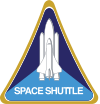STS-26
| Missionsemblem | |||||
|---|---|---|---|---|---|
 | |||||
| Missionsstatistik | |||||
| Missionsnavn: | STS-26 | ||||
| Rumagentur: | NASA | ||||
| Rumfærge: | Discovery (7) | ||||
| Antal besætningsmedlemmer: | 5 | ||||
| Affyringsrampe: | LC-39B (KSC) | ||||
| Opsendelse: | 29. september 1988 | ||||
| Landing: | 3. oktober 1988 | ||||
| Landet på: | Edwards Air Force Base | ||||
| Varighed: | 4 dage | ||||
| Foto af besætningen | |||||
 | |||||
| Navigation | |||||
| |||||
STS-26 var Discoverys syvende rumfærge-mission. Opsendt 29. september 1988 og vendte tilbage den 3. oktober 1988. Missionen blev kaldt "Return to flight" (genoptagelse af flyvning), det var den første flyvning, efter Challenger-ulykken i 1986. Challenger var 2 år før var styrtet ned under opsendelsen.
Missionen satte kommunikationssatellitten Tracking and Data Relay Satellite (TDRS-3) i kredsløb[1].
Rumfærgerne var redesignet efter omfattende anbefalinger fra Rogers-kommissionen[2] [3] [4].
Besætning

 Frederick H. Hauck (kaptajn)
Frederick H. Hauck (kaptajn)
 Richard C. Covey (pilot)
Richard C. Covey (pilot)
 John M. Lounge (1. missionsspecialist)
John M. Lounge (1. missionsspecialist)
 George D. Nelson (2. missionsspecialist)
George D. Nelson (2. missionsspecialist)
 David C. Hilmers (3. missionsspecialist)
David C. Hilmers (3. missionsspecialist)
Eksterne henvisninger
- STS-26 NASA (engelsk)
- Tracking and Data Relay Satellite System (TDRSS) Arkiveret 31. juli 2007 hos Wayback Machine NASA (engelsk)
- ^ Tracking and Data Relay Satellite System (TDRSS)TDRS-C Arkiveret 12. december 2007 hos Wayback Machine (engelsk)
- ^ Major Orbiter Modifications (engelsk)
- ^ Major SRB Modifications (engelsk)
- ^ Major Space Shuttle Main Engine Modifications (engelsk)
| ||||||||
| ||||||||||||||||||||
Medier brugt på denne side
Forfatter/Opretter: Kwamikagami, Licens: CC BY-SA 4.0
symbol of Mars. 16 × 16 pixel nominal dimensions, lines 2 pixel thick, square caps. Colour 75% blue: red=0 green=0 blue=191 (#0000BF).
Rotated and color enhanced version of original (ISS013-E-48788 (6 July 2006) --- The Space Shuttle Discovery approaches the International Space Station for docking but before the link-up occurred, the orbiter "posed" for a thorough series of inspection photos. Leonardo Multipurpose Logistics Module can be seen in the shuttle's cargo bay. Discovery docked at the station's Pressurized Mating Adapter 2 at 9:52 a.m. CDT, July 6, 2006.)
SVG version of PNG Space Shuttle Logo/Patch.
STS-51-L INSIGNIA
- Members of the STS-51L crew designed this patch which will represent their participation on NASA's late January 1986 mission aboard the space shuttle Challenger, depicted launching from Florida and soaring into space to carry out a variety of goals. Among the prescribed duties of the five astronauts and two payload specialists will be observation and photography of Halley's Comet, backdropped against the United States flag in the insignia. Surnames of the crew members encircle the scene, with the payload specialists being recognized below. Surname of the first teacher in space, Sharon Christa McAuliffe, is followed by a symbolic apple. Gregory Jarvis, representing Hughes, is the industrial payload specialist for the flight. NASA's crew members are astronauts Francis R. (Dick) Scobee, commander; Michael J. Smith, pilot; and Ronald E. McNair, Ellison S. Onizuka and Judith A. Resnik - all mission specialists.
STS-27 Mission Insignia
The STS-26 Return to Flight crew are, in the back row from left to right: Mission Specialist Mike Lounge, Mission Specialist David C. Hilmers, Mission Specialist George D. Nelson. Front row: Pilot Richard O. Covey and Commander Frederick H. Hauck. The crew is pictured wearing their orange Launch and Entry Suits (LES). The mission emblem is displayed in the background.
The predominant themes are: a new beginning (sunrise), a safe mission (stylized launch and plume), the building upon the traditional strengths of NASA (the red vector which symbolizes aeronautics on the original NASA insignia), and a remembrance of their seven colleagues who died aboard Challenger (the seven-starred Big Dipper). The patch was designed by artist Stephen R. Hustvedt of Annapolis, MD.









